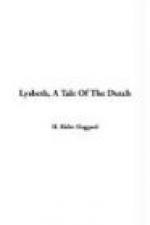Fanatics sprang at the screens and the altars, “all the carved work thereof they break down with hatchet and hammer,” they tore the hangings from the shrines, they found the sacred cups, and filling them with sacramental wine, drank with gusts of ribald laughter. In the centre of the choir they built a bonfire, and fed it with pictures, carvings, and oaken benches, so that it blazed and roared furiously. On to it—for this mob did not come to steal but to work vengeance—they threw utensils of gold and silver, the priceless jewelled offerings of generations, and danced around its flames in triumph, while from every side came the crash of falling statues and the tinkling of shattered glass.
The light of that furnace shone through the lattice stonework of the tomb, and in its lurid and ominous glare Adrian beheld the faces of those who refuged with him. What a picture it was; the niches filled with mouldering boxes, the white gleam of human bones that here and there had fallen from them, the bright furnishings and velvet pall of the coffin of the newcomer on which he stood—and then those faces. The priests, still crouched in corners, rolling on the ground, their white lips muttering who knows what; the sacristan in a swoon, Hague Simon hugging a coffin in a niche, as a drowning man hugs a plank, and, standing in the midst of them, calm, sardonic and watchful, a drawn rapier in his hand, his father Ramiro.
“We are lost,” moaned a priest, losing control of himself. “We are lost. They will kill us as they have killed the holy Abbe.”
“We are not lost,” hissed Ramiro, “we are quite safe, but, friend, if you open that cursed mouth of yours again it shall be for the last time,” and he lifted his sword, adding, “Silence; he who speaks, dies.”
How long did it last? Was it one hour, or two or three? None of them knew, but at length the image-breaking was done, and it came to an end. The interior of the church, with all its wealth and adornments, was utterly destroyed, but happily the flames did not reach the roof, and the walls could not catch fire.
By degrees the iconoclasts wearied; there seemed to be nothing more to break, and the smoke choked them. Two or three at a time they left the ravaged place, and once more it became solemn and empty; a symbol of Eternity mocking Time, of Peace conquering Tumult, of the Patience and Purpose of God triumphant over the passions and ravings of Man. Little curls of smoke went up from the smouldering fire; now and again a fragment of shattered stonework fell with an echoing crash, and the cold wind of the coming winter sighed through the gaping windows. The deed was done, the revenge of a tortured multitude had set its seal upon the ancient fane in which their forefathers worshipped for a score of generations, and once more quiet brooded upon the place, and the shafts of the sweet moonlight pierced its desecrated solitudes.
One by one, like ghosts arising at a summons of the Spirit, the fugitives crept from the shelter of the tomb, crept across the transepts to the little door of the baptistery, and with infinite peeping and precaution, out into the night, to vanish this way and that, hugging their hearts as though to feel whether they still beat safely in their bosoms.




